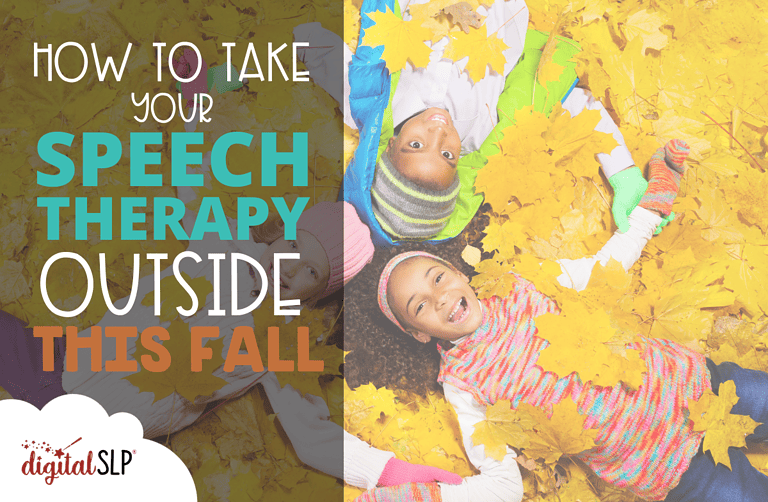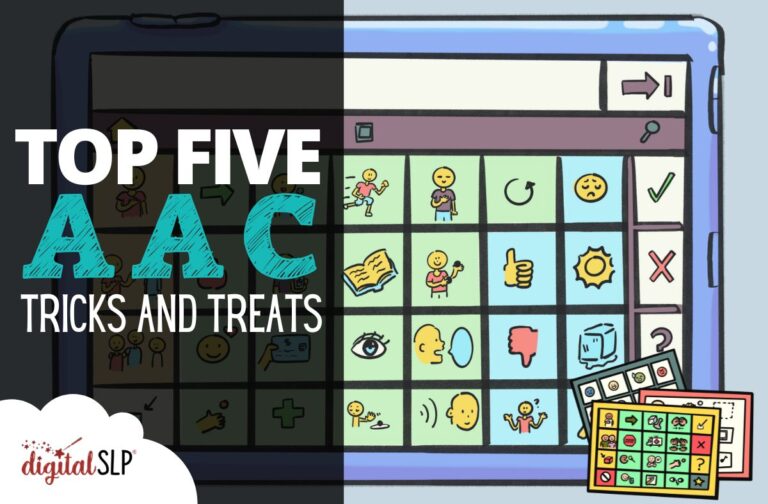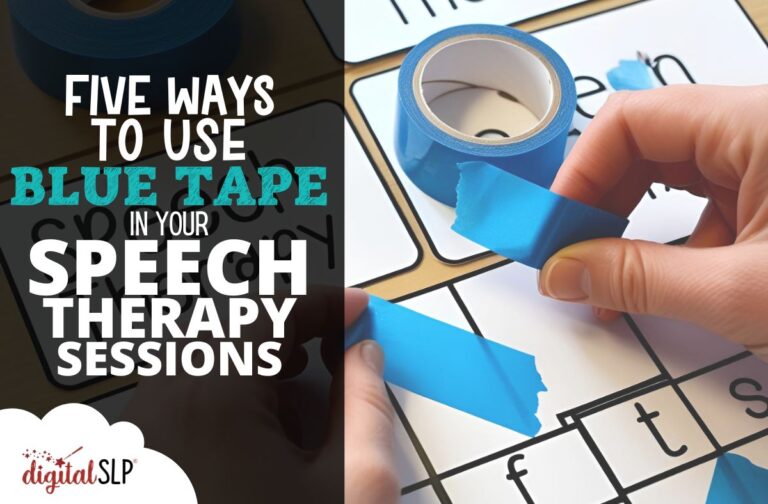This post is all about how to take your speech therapy outside this fall! Fall is wonderful in so many ways! The air is crisp, the leaves are vibrant, and the sweaters are out of storage. But all the pumpkin spice lattes in the world can’t hide the fact that fall is also challenging! It’s the season of schedule changes, baseline data, and referrals.
When life feels overwhelming, one of my go-to strategies is heading outside—and science backs me up on this! In 2019, researchers from the University of Michigan found that study participants who spent just ten minutes in nature, three times a week, had lower levels of cortisol (a biomarker related to stress).
Going outside helps students, too! Researchers have found that time in nature is correlated with improved mental health and reduced ADHD-related challenges in children. One study even noted that nature-based activities facilitated social engagement for autistic students.
Given these findings—and what we know from personal experience (I just feel better after being outside!)—it makes sense that it could be helpful to move some of our speech sessions outdoors this fall. But the planning and logistics can be a barrier, and the last thing any SLP needs is more work—so we’ve done the work for you! Keep reading for my top five ideas for taking your speech therapy outside this fall.
- Relocate or Repurpose Your Favorites:
Many popular games can be seamlessly moved outside. Some of them might even be BETTER outside! Here are some examples:
- Jenga: Who doesn’t love this classic?? It’s the perfect pal for nearly any target, because it’s simple and moves quickly—students can say a word or answer a question with each turn, and get plenty of practice. To move it outside, just dump your blocks in a bag, grab word lists or flash cards, and go! As a bonus, students who love the game but not the noisy crashing blocks may find that playing outside feels more manageable.
To take your outdoor Jenga experience to the next level, try “giant Jenga”! It has the same rules and format as the original, just supersized. There’s an official version, and you can also find options from Pottery Barn, Target, or even Etsy, using search terms like “tower game.” They’re expensive and require some storage space, so it might be worthwhile to share ownership with a colleague.
- Bowling and Ring Toss: I love using bowling and ring toss games in speech! They involve plenty of movement, and like Jenga, they can be paired with almost any goal. If you already have bowling and/or ring toss sets, you can probably take them outside without any adjustments (just enlist your students to help you carry the pieces!).
If you don’t have bowling or ring toss in your SLP toolbox yet, it’s a great opportunity for some DIY adventures! You can make bowling sets out of plastic bottles, toilet paper tubes, or even pool noodles. If ring toss is more your style, try creating your own using paper plates, rope, or cardboard. Making these sets can also be part of your speech sessions, resulting in practice with sequencing, describing, and following directions.
- Any Card Game: Card games might not seem like good candidates for outside play, but hear me out on this one. If you have a laminator, any card game can become outdoor-friendly! Just run the cards through the laminator, cut them apart, and they can be used anywhere and easily wiped clean as needed.
- Compare and Contrast: After your students have tried indoor and outdoor versions of the same game, they could identify the similarities and differences between the two experiences! They could also discuss which option they prefer, and provide details to support their choices.
- Chalk It Up:
As fun as it is to bring your indoor favorites outside, it’s also exciting to explore options that work best outside—they feel extra special! In this category, chalk is the clear winner (and you can bring it indoors if you have a chalkboard!). It’s cheap, accessible, and easy to clean, and it can be used to work on SO many different skills. Here are a few of my favorites:
- Tic-Tac-Toe and Hopscotch: For active preschool and early elementary students, outdoor tic-tac-toe and hopscotch are perfect for practicing taking turns and following directions.
- Encouraging Messages: If your school’s admin team is on board, students could use chalk to write kind notes on the asphalt and sidewalks throughout the school property. This activity could easily fill several sessions and target multiple goal areas, as students research/brainstorm quotes and messages to include, use accurate syntax, and incorporate perspective-taking skills to decide what messages their fellow students would most appreciate.
- Art Adventures: When students love to create but struggle with perfectionism, chalk art can be very freeing! Students could create sidewalk drawings and then describe their work, and ask questions (or give compliments) about other students’ art.
- Pretend Play:
Play skills are closely connected to language development, and pretend play is full of opportunities to practice personal narrative, sequencing, describing, and more. While it can feel fun and silly to “camp” or “have a picnic” in the speech room, bringing these activities outside provides a supportive layer of realism for students who find pretend play to be challenging. If you decide to give this a try, you might even want to bring in your “real” camping and picnic gear from home!
- Students in Charge:
Outdoor activities allow students to embrace teamwork, develop leadership skills, and practice creativity. There are so many possibilities here, but two of my favorites are creating an obstacle course or a scavenger hunt. The planning sessions leading up to the actual outdoor experience are a great time to work on executive function, self-advocacy, and sequencing—and then the activities themselves are ideal for flexibility, following directions, and social interaction. With a little preparation, the activities could even be designed to include articulation practice; e.g., in the scavenger hunt, each item the students look for could include a target sound.
- Classic Outdoor Options:
The outdoor games that many of us learned as kids are amazingly relevant for speech therapy sessions! Here are a few that I especially love:
- Red Light, Green Light: This game couldn’t be simpler. Students line up several yards away, and when you shout “green light!” they start moving towards you. When you shout “red light!” they stop. If any student continues to move after a red light, they’re “out,” but this rule can be adjusted for your students’ needs. Repeat the “red light, green light” process until a student reaches you, and then they can become the new light! This one is great for building attention and following directions.
- SLP May I? and Simon Says: The setup for SLP May I? (a twist on Mother May I?) is similar to Red Light, Green Light. Students line up, and you call one of them by name and give them some silly instructions (e.g., hop on one foot five times). The twist is that before they follow the instructions, the student needs to ask, “SLP, may I?” and wait for you to respond. It’s excellent for yes/no questions, verbs, following directions, and auditory comprehension.
- Simon Says has a similar initial setup! In this game, the leader provides directions (e.g., do the chicken dance) for the rest of the group to follow, but the catch is that the directions must be preceded with “Simon says”—otherwise, the group should ignore them. If a student does the action when the leader didn’t say “Simon says,” they’re “out” (or they could be the winner!). This one is great for verbs, auditory comprehension, and following directions.
- Animal/TV/Movie/Food/Song Tag: This version of tag is perfect for categories practice! It’s like regular tag: one person is “it,” running around and trying to tag the others. When someone gets tagged, they have to “freeze” in whatever position they were in (always good for a giggle). The good news is that the other players can come by and “unfreeze” them with a gentle tap on the shoulder—but first the frozen player must yell out the name of an item from the designated category. So, if you’re playing Food Tag, the student could yell “cake!” and then be “thawed.”
One quick caveat to keep in mind with all of these ideas is that exciting changes (e.g., speech outside!) are still changes, and change is tough for many of our students. Help them prepare by giving them as much information and advance warning as possible, and consider building a reliable “outside speech” routine to follow. And of course, be aware of allergies, mobility needs, and other accessibility factors.
I hope these ideas bring some fun to your speech therapy outside this fall! If you give any of them a try (or you have suggestions to add to the list), please share in the comments!













Recent Comments